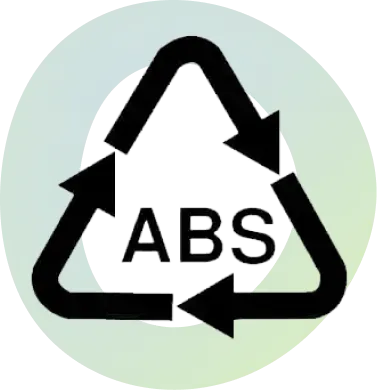Acrylonitrile Butadiene Styrene (ABS)
Acrylonitrile Butadiene Styrene (ABS) Recycling
Reclaim
Acrylonitrile butadiene styrene, commonly referred to as “ABS”, is a very popular engineering thermoplastic, often chosen for its low-cost, and highly impact-resistant properties (though to a slightly lesser extent than polycarbonate). Being an amorphous thermoplastic – meaning it can be melted and extruded multiple times, at relatively low melting points, even after initially solidifying – make it a popular choice for low-heat applications that call for a structurally resistant, rigid, and cheap plastic [1].
These chemical and physical properties are largely a result of the molecular structure of ABS plastic, being composed of three distinct chemical components. The acrylonitrile contributes to the strength, chemical and heat stability of the plastic while the butadiene contributes to the durability, impact resistance, and toughness of the plastic, and the styrene allows the plastic to have a smooth finish, while also improving processability of the plastic [2, 3].
Due to being a thermoplastic, and not having any appreciable degradation in quality after being melted and re-extruded, ABS is very conducive to being recycled. The temperatures required to melt solidified ABS are easily achievable even on a domestic scale – one of the reasons why ABS is a popular consumer-grade 3D printing filament [1].
ABS is also relatively inert, resulting in its almost ubiquitous use in products ranging from car dashboards and steering wheel covers to children’s toys (such as Lego bricks®), keyboard keycaps, plastic guards on power outlets, and much more.
The recycling process for ABS is similar to other rigid plastics and is facilitated by its easy melting. Recycled ABS input can be mixed with virgin resin in the manufacturing of new products while retaining product quality [3].

ABS is not conventially recycled through street-collection programs, and as such does not have its own unique resin identitifcation number. Alternatively, it can be classified under code 7, or “other”.
References
[1] T. Rogers, “Everything You Need to Know About ABS Plastic,” Creativemechanisms.com, Jul. 13, 2015. https://www.creativemechanisms.com/blog/everything-you-need-to-know-about-abs-plastic (accessed Jul. 28, 2021).
[2] Y. Vihaan, “ABS plastic recycling – everything you need know | 3DRIFIC,” 3drific, Mar. 14, 2021.https://3drific.com/abs-plastic-recycling-everything-you-need-know/ (accessed Jul. 28, 2021).
[3] Omnexus, “Acrylonitrile Butadiene Styrene (ABS Plastic): Uses, Properties & Structure,” Specialchem.com, 2019. https://omnexus.specialchem.com/selection-guide/acrylonitrile-butadiene-styrene-abs-plastic (accessed Jul. 28, 2021).

Carstar
“We are proud to recycle our scrap bumper plastics rather than add to the landfill. Reclaim has helped us do this.”
Kris Kurman
Manager
Schedule an appointment today!
Reclaiming our environment by Reclaiming the plastic waste we produce.

